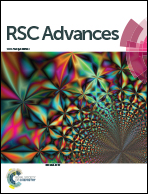Modification of abandoned fine blue-coke: optimization study on removal of p-nitrophenol using response surface methodology
Abstract
Abandoned fine blue-coke was modified with a physicochemical method including nitric acid (HNO3) treatment and nitrogen gas (N2) calcination, and used as an adsorbent for p-nitrophenol (PNP) removal. The preparation process was optimized to improve the adsorption ability based on the 2IV6–2 fractional factorial design, steepest ascending method and the Box–Behnken design (BBD) of the response surface methodology (RSM) technique. The significant factors on each experimental design response were identified by means of analysis of variance (ANOVA). The predicted adsorption capacity of PNP on MFBC was found to agree with the experimental values. The optimum experimental conditions were as follows: HNO3 concentration: 4.46 mol L−1, modification temperature: 87.8 °C, modification time: 20.3 h, impregnation ratio of HNO3 to MFBC: 10 mL/1 g, calcination time: 2 h, and calcination temperature: 716 °C. Moreover, surface roughness of the MFBC was found to increase obviously after the modification by FESEM and HRTEM analysis, and the total pore volume and specific surface area increased by 0.8 and 1.2 times, respectively. The PNP equilibrium adsorption capacity of MFBC was found to be 156.9 mg g−1 at 328 K, which highlights its potential application in wastewater treatment.


 Please wait while we load your content...
Please wait while we load your content...